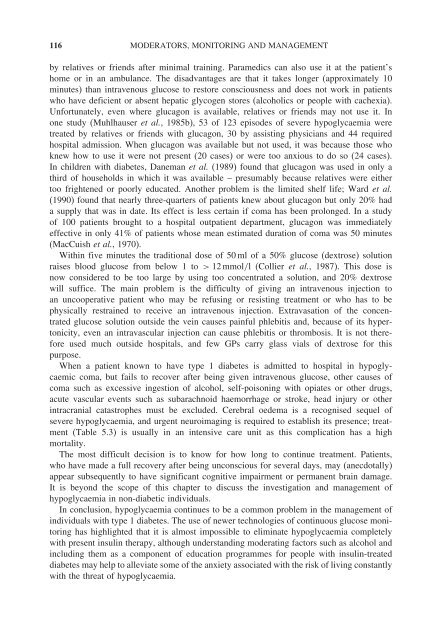Hypoglycaemia in Clinical Diabetes
Hypoglycaemia in Clinical Diabetes
Hypoglycaemia in Clinical Diabetes
- No tags were found...
You also want an ePaper? Increase the reach of your titles
YUMPU automatically turns print PDFs into web optimized ePapers that Google loves.
116 MODERATORS, MONITORING AND MANAGEMENTby relatives or friends after m<strong>in</strong>imal tra<strong>in</strong><strong>in</strong>g. Paramedics can also use it at the patient’shome or <strong>in</strong> an ambulance. The disadvantages are that it takes longer (approximately 10m<strong>in</strong>utes) than <strong>in</strong>travenous glucose to restore consciousness and does not work <strong>in</strong> patientswho have deficient or absent hepatic glycogen stores (alcoholics or people with cachexia).Unfortunately, even where glucagon is available, relatives or friends may not use it. Inone study (Muhlhauser et al., 1985b), 53 of 123 episodes of severe hypoglycaemia weretreated by relatives or friends with glucagon, 30 by assist<strong>in</strong>g physicians and 44 requiredhospital admission. When glucagon was available but not used, it was because those whoknew how to use it were not present (20 cases) or were too anxious to do so (24 cases).In children with diabetes, Daneman et al. (1989) found that glucagon was used <strong>in</strong> only athird of households <strong>in</strong> which it was available – presumably because relatives were eithertoo frightened or poorly educated. Another problem is the limited shelf life; Ward et al.(1990) found that nearly three-quarters of patients knew about glucagon but only 20% hada supply that was <strong>in</strong> date. Its effect is less certa<strong>in</strong> if coma has been prolonged. In a studyof 100 patients brought to a hospital outpatient department, glucagon was immediatelyeffective <strong>in</strong> only 41% of patients whose mean estimated duration of coma was 50 m<strong>in</strong>utes(MacCuish et al., 1970).With<strong>in</strong> five m<strong>in</strong>utes the traditional dose of 50 ml of a 50% glucose (dextrose) solutionraises blood glucose from below 1 to > 12 mmol/l (Collier et al., 1987). This dose isnow considered to be too large by us<strong>in</strong>g too concentrated a solution, and 20% dextrosewill suffice. The ma<strong>in</strong> problem is the difficulty of giv<strong>in</strong>g an <strong>in</strong>travenous <strong>in</strong>jection toan uncooperative patient who may be refus<strong>in</strong>g or resist<strong>in</strong>g treatment or who has to bephysically restra<strong>in</strong>ed to receive an <strong>in</strong>travenous <strong>in</strong>jection. Extravasation of the concentratedglucose solution outside the ve<strong>in</strong> causes pa<strong>in</strong>ful phlebitis and, because of its hypertonicity,even an <strong>in</strong>travascular <strong>in</strong>jection can cause phlebitis or thrombosis. It is not thereforeused much outside hospitals, and few GPs carry glass vials of dextrose for thispurpose.When a patient known to have type 1 diabetes is admitted to hospital <strong>in</strong> hypoglycaemiccoma, but fails to recover after be<strong>in</strong>g given <strong>in</strong>travenous glucose, other causes ofcoma such as excessive <strong>in</strong>gestion of alcohol, self-poison<strong>in</strong>g with opiates or other drugs,acute vascular events such as subarachnoid haemorrhage or stroke, head <strong>in</strong>jury or other<strong>in</strong>tracranial catastrophes must be excluded. Cerebral oedema is a recognised sequel ofsevere hypoglycaemia, and urgent neuroimag<strong>in</strong>g is required to establish its presence; treatment(Table 5.3) is usually <strong>in</strong> an <strong>in</strong>tensive care unit as this complication has a highmortality.The most difficult decision is to know for how long to cont<strong>in</strong>ue treatment. Patients,who have made a full recovery after be<strong>in</strong>g unconscious for several days, may (anecdotally)appear subsequently to have significant cognitive impairment or permanent bra<strong>in</strong> damage.It is beyond the scope of this chapter to discuss the <strong>in</strong>vestigation and management ofhypoglycaemia <strong>in</strong> non-diabetic <strong>in</strong>dividuals.In conclusion, hypoglycaemia cont<strong>in</strong>ues to be a common problem <strong>in</strong> the management of<strong>in</strong>dividuals with type 1 diabetes. The use of newer technologies of cont<strong>in</strong>uous glucose monitor<strong>in</strong>ghas highlighted that it is almost impossible to elim<strong>in</strong>ate hypoglycaemia completelywith present <strong>in</strong>sul<strong>in</strong> therapy, although understand<strong>in</strong>g moderat<strong>in</strong>g factors such as alcohol and<strong>in</strong>clud<strong>in</strong>g them as a component of education programmes for people with <strong>in</strong>sul<strong>in</strong>-treateddiabetes may help to alleviate some of the anxiety associated with the risk of liv<strong>in</strong>g constantlywith the threat of hypoglycaemia.
















